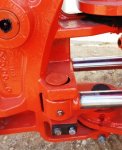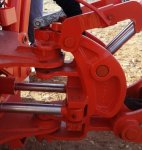I just bought my first tractor (Kubota L39 TLB) at a Lyon & Son auction and made a mistake. I thought I’d looked over everything pretty well but missed the right-side (top and bottom) pin-hole elongation on the swing frame that the alleged A-hole mechanic at Ahern Rental covered up by welding a large fender washer to the top of the pin and then painting it all Kubota-orange. The manufactured 1-1/4” bored holes (top and bottom) now have nearly a 1-3/4” outside diameter. So now the questions.
Should I cut my losses early and simply purchase a new swing frame and pin – roughly a $1000 investment in parts, or do I take the assembly to a machinist to attempt a fix? And, if the latter, should the pin holes first be filled with metal weld and then rebored, probably sized for a press fit sleeve bushing, or do I attempt to cold-weld (JB Weld or metal epoxy) a top and bottom sleeve bushing (1-1/2” OD) or flanged sleeve bushing (again 1-1-2” OD with the flange (1-3/4” OD) being closer in diameter to the elongated holes), or do I have the holes resized for a high load, sealed ball bearing (the one I found has an OD of 2-9/16”), or something else all together?
My concern with filling the holes first with metal weld before having them rebored is that the resulting heat may make that area of the frame too brittle and the inherent voids in the weld may compromise the needed strength. My concern with the cold weld options securing sleeve bushings is that the fill won’t be strong enough for the imparted forces. My concern with making the holes bigger for a ball bearing (or even leaving them the size they are) is losing the meat of the frame and possibly making the whole assembly too weak.
And as a side, what would have caused this in the first place? The other (left) side frame hole and pin look good as new. Why would one side get so buggered up and not the other? Was this likely caused by the original swing frame being defective or is this type of wear to be expected?
Any knowing experience or intelligence would be greatly appreciated.
Should I cut my losses early and simply purchase a new swing frame and pin – roughly a $1000 investment in parts, or do I take the assembly to a machinist to attempt a fix? And, if the latter, should the pin holes first be filled with metal weld and then rebored, probably sized for a press fit sleeve bushing, or do I attempt to cold-weld (JB Weld or metal epoxy) a top and bottom sleeve bushing (1-1/2” OD) or flanged sleeve bushing (again 1-1-2” OD with the flange (1-3/4” OD) being closer in diameter to the elongated holes), or do I have the holes resized for a high load, sealed ball bearing (the one I found has an OD of 2-9/16”), or something else all together?
My concern with filling the holes first with metal weld before having them rebored is that the resulting heat may make that area of the frame too brittle and the inherent voids in the weld may compromise the needed strength. My concern with the cold weld options securing sleeve bushings is that the fill won’t be strong enough for the imparted forces. My concern with making the holes bigger for a ball bearing (or even leaving them the size they are) is losing the meat of the frame and possibly making the whole assembly too weak.
And as a side, what would have caused this in the first place? The other (left) side frame hole and pin look good as new. Why would one side get so buggered up and not the other? Was this likely caused by the original swing frame being defective or is this type of wear to be expected?
Any knowing experience or intelligence would be greatly appreciated.



